Google released the 2017 Beverage Trends report, have you tried all the hottest ones?
For professional baristas, please follow the coffee workshop (Wechat official account cafe_style)
Google recently released a "Beverage Trends report 2017", sharing several beverage consumption trends based on massive search data.
Research methods: search big data + popular video analysis + consumer interviews
In this study, Google first used popular beverage terms searched by Google between April 2015 and March 2017 from Internet users in the United States, the United Kingdom, Spain and Mexico to summarize the main search trends. then, after excluding the seasonal effects of these hot words, calculate the year-on-year increase, rate and acceleration of their search volume.
At the same time, Google also analyzed the content of YouTube popular drink videos and interviewed more than 1000 consumers in four countries to learn more about what big data means to the lives of local people.
Based on this approach, Google identified three major trends in the popularity of beverages in 2017: "cold production", natural taste and high-end water. Limited to the length of the article, only some of the conclusions with the highest relevance to Chinese consumers are extracted below, and the full report is detailed at the end of the article.
Cold Coffee, Starbucks and opposite Wind
The Google report argues that the process of making a drink is becoming as important as its composition list, whether it's in pursuit of health, taste or feel-good self-esteem.
Among them, "cold production", represented by cold-extracted coffee and cold-brewed tea, has become a popular trend in the beverage industry in recent years.
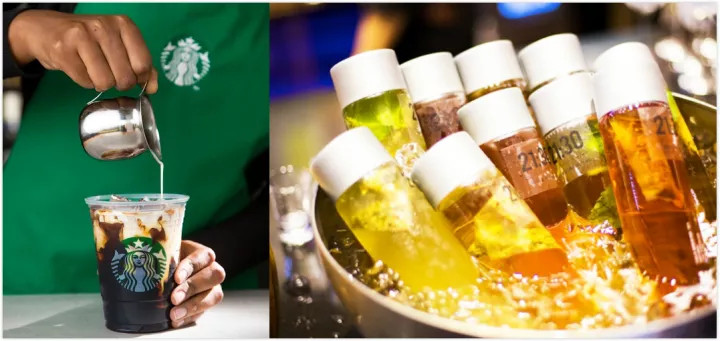
The picture on the left shows Starbucks making cold coffee, and the picture on the right shows the Internet celebrity cold brewed tea.
Take the production of cold extraction (cold brew) coffee as an example. Generally speaking, coffee powder needs to be soaked in cold water for 12-24 hours before extraction and filtration.
Many people may think that a wave of coffee retail brands such as Starbucks brought the new product on fire. But Google's search data found that the popularity of cold-extracted coffee had something to do with the popularity of handmade coffee in 2012.
The number of searches for the word "DIY cold extract" has increased significantly since 2012, compared with slightly less hot searches for cold extraction machines.
Since 2015, the attention and innovation of brands have further contributed to the popularity of cold-extracted coffee. But on the whole, the main search for cold coffee still comes from the towering green line below-"DIY".
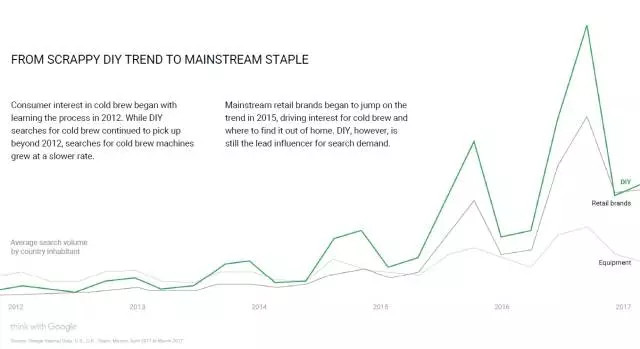
Buzzwords related to cold coffee-Google search trends for DIY, retail brands and devices since 2012
This speculation has also been confirmed in YouTube-related popular videos.
The report points out that these highly clicked cold coffee videos focus on educating users to make coffee, with DIY coffee tools such as Mason bottles and filter paper being most frequently mentioned.
Natural flavor is popular
The report points out that the second major trend in the beverage industry is a more natural and approachable flavor.
Among the four markets tracked by the report, ginger, matcha, turmeric and Indian milk tea were the four most sought-after beverage flavors in these regions.
These approachable flavor drinks are popular for different reasons: for example, matcha, smooth and full taste is very powdery, while ginger is more beneficial to human health, including anti-oxidation, digestion and so on.
But for brands, the search data for relevant hot words provides an interesting perspective for new product development.
For example, ginger tea, ginger beer and Ginger Ale are the three most popular categories of ginger drinks. Moreover, searches for ginger juice, ginger cold tea and ginger water have exploded in recent years, with the number of searches in the four markets growing at an annual rate of 79 per cent, much higher than the 32 per cent for ginger tea, ginger beer and Ginger Ale.
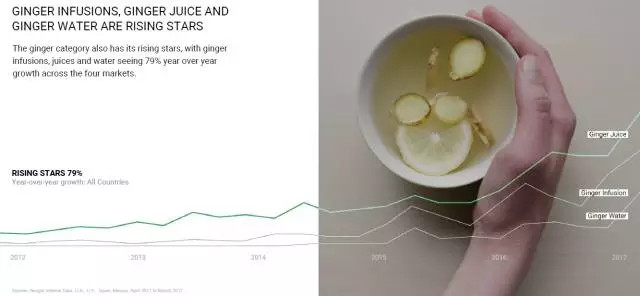
Google search trends for ginger juice, ginger cold tea and ginger water since 2012
In addition, when ginger is mixed with other flavors to make seasoned drinks, the preferences of people in different countries are slightly different.
Users in the US, UK and Spain prefer ginger with lemon, honey and turmeric, while Mexico is slightly different, with the exception of turmeric, locals prefer ginger with cinnamon and fennel, according to Google search data.
By contrast, the flavor combination of matcha is much more monotonous, nothing more than cream, milk and chocolate.
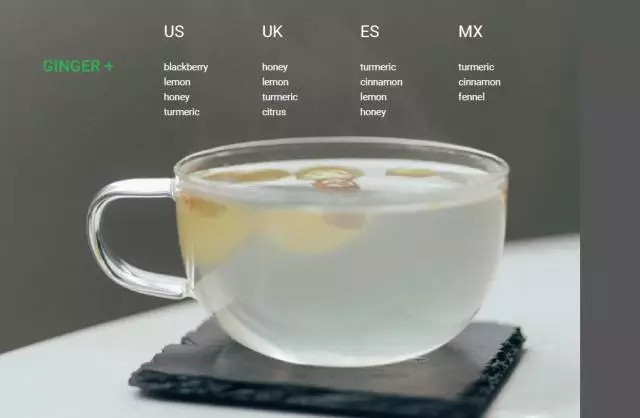
Popular search terms for "ginger" in the United States, Britain, Spain and Mexico
People are always picky about drinking water.
In addition, with the improvement of people's health awareness, great changes have taken place in our requirements for water.
On the one hand, consumers want to be able to replenish more water at any time, so Google search data show that there is a high search volume of words that indicate capacity, such as gallons and large bottles.
At the same time, in order to meet the requirements of clean water quality, people pay special attention to water purifiers and drinking fountains.
Google captured the top 100 videos about water purifiers and drinking fountains on YouTube in four countries and found that for water purifiers, consumers are most concerned about the cleanliness, safety and bacteria content of water before and after filtration.
On the other hand, drinking fountains pay more attention to household scenes and conveniences, such as convenient heating, good taste, convenient drinking, no BPA and other factors.
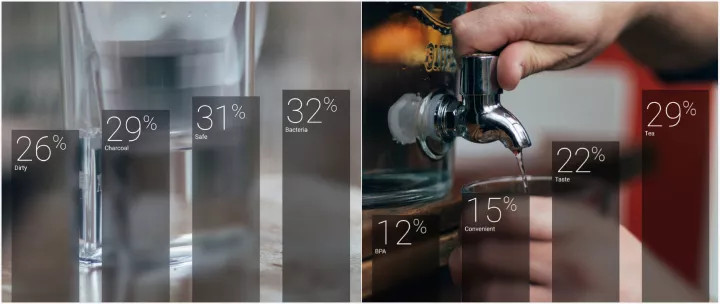
The picture on the left shows the keywords of the popular video about water purifiers on YouTube-bacteria, safety, activated carbon and dirt-while the picture on the right shows the keywords of the hot video about water dispensers on YouTube-tea, taste, convenience, BPA.
On the other hand, judging from the popularity of Google search, there is a growing interest in alkaline water, bubble water and high-end packaging water. Especially in the United States, the search for alkaline water is unstoppable.
Although Google's report is aimed at four European and American markets, its method of insight into market trends based on consumer search behavior, as well as these observations themselves, is of great reference value to practitioners and researchers in the Chinese beverage market.
What's more, when you are in China, you may have tried these new beverage stars in the past summer, such as the Paris water that occupied the freezer of the convenience store overnight and all kinds of new plant functional drinks. After reading this report, you may be able to better understand these new trends in the beverage industry.
The pictures and contents of this article refer to Google's Beverage trend report 2017.
Important Notice :
前街咖啡 FrontStreet Coffee has moved to new addredd:
FrontStreet Coffee Address: 315,Donghua East Road,GuangZhou
Tel:020 38364473
- Prev

Refreshing yourself with coffee, did you pick the right time to drink it?
Communication of professional baristas pay attention to coffee workshop (Wechat official account cafe_style) Coffee has become an indispensable drink for many people every day. Many reports and studies have shown that proper black coffee is helpful to refresh the mind, but do you know when to drink coffee is the most effective? We rely on our own hormone cycle to adjust our daily body routine, that is,
- Next
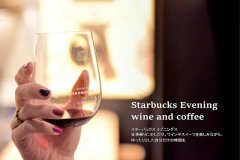
Tokyo Coffee | this Starbucks does not sell you coffee, but sells you a glass of wine.
For the exchange of professional baristas, please follow the coffee workshop (Wechat official account cafe_style) address: 3-3-1 Maruchi, Chiyoda District, Tokyo (behind the KITTE Building in Tokyo). Business hours: 7: 00 a.m. to 22:30 on weekdays, 8: 00 a.m. to 21:00 on Saturdays, and 10:00 to 20:00 on Sundays. For every trip agreed upon, choose an evening for a drink.
Related
- Why can American refills for free? The difference between Americano and American drip pot coffee
- Being chased out of the rain in front of Starbucks?! Store: Sheltering from rain under umbrellas poses a safety hazard
- The white moonlight has changed?! Lucky launches "Big Winter Pear American"
- Hand-brewed coffee three-stage method, high-sweet and universal brewing method to share! What does the high sweet water level of hand-brewed coffee mean?
- What is the difference between raw, refined and full espresso coffee? How to extract espresso and taste good?
- A complete list of coffee bean names and their meanings! What is Yejia Shefi coffee? Where is Mantelin coffee?
- What grade does Arida Manor Kaduai coffee beans belong to? What treatment is Arida ASD slow anaerobic sun exposure?
- The milk tea cup becomes smaller?! Overlord Tea Girl launches a new "Return to Yunnan" series
- Accused of selling counterfeit and high-priced coffee beans! Well-known boutique coffee brand "Oukelao" bowed and apologized!
- How to make espresso dumplings? Can I eat coffee and glutinous rice balls together?

